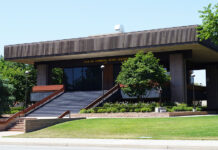Following an exhaustive review of its proposed $20 million 2021-22 budget, the city council voted unanimously to adopt the new spending plan that restores many previously frozen staff positions and creates a capital improvement plan to restore many projects previously on hold.
According to Mayor Mark Chirco, the city’s plan adheres to the fiscal sustainability pledge yet does reflect a city again on the move.
At the heart of the revised budget plan is the 2020 voter approval of Measure Y, which provides the city with an additional 1.5 cent increase in sales tax collections for every dollar spent inside the city on affected goods and services.
Los Alamitos had faced dire financial consequences for the past few years, yet made the case to voters under the previous council, led by former Mayor Richard Murphy, as they made the case that it was time for voters to invest in the future.
Though the margin was razor thin, voters approved Measure Y, which now allows the council to adjust its budget to reflect this new investment.
During the public hearing on the proposed budget, Koehler gave the council, and taxpayers, an overview of his department’s management of $12 million in city investments and its $3 million in debts, which he said was part of more than 22 separate funds managed by the finance department.
The city’s finance department has projected in its five-year forecast that Measure Y, coupled with a robust economy that will also increase other fee-based income, could bring in more than $4 million per year to city coffers.
Under the new spending plan, the city’s capital improvement plan is five times larger than previous years and, according to the forecast presented by interim Finance Director Craig Koehler, the city could amass a surplus of more than $10 million over the next five years if spending and revenue levels remain consistent.
Kohler said the current economic recovery is the “fastest growth in history.” He said the boom is showing itself in construction and building materials, while some sectors like business travel might take as long as three years to fully return to previous levels.
The city’s fiscal 2021-22 budget reflects $19.9 million in projected revenue, and $19 million in spending, producing a projected surplus of just under $1 million.
While the draft budget reflected a slightly higher surplus, the council agreed to also include a $1.6 million initiative to immediately improve many city streets. While not all of funding required for the street improvement plan would come out of the general fund, the adjustment to include it absorbed some of the earlier projected surplus.
In addition, the city now expects to receive $2.7 million from the federal American Rescue Plan over the next two years, which has not yet been budgeted and will not be until all of the regulations are released.
Like other cities, Los Alamitos officials say they will double down to reinvest in the city’s infrastructure. According to city manager Chet Simmons, the spending plan is “a very aggressive, but needed approach to shore up the city’s infrastructure.”
Acting Deputy City Manager Ron Noda gave the Council an overview of the proposed capital improvement and development plan, which includes major investments in technology to put more power in the hands of constituents.
“Our overall goal is to improve customer service,” he said, noting that new software that will allow for online payments, code enforcement, digital scheduling, among other enhancements, and will improve the overall “customer experience” for city residents.
While technology is a great thing, council member Ron Bates interjected a thought to remember that the population was “aging,” so he urged the administration not to lose sight of the in-person experience as well in its planning.
Noda said the staff still prefers in-person experiences, but the new digital options will allow for greater convenience for all citizens.
Responding to a question from Mayor Pro Tem Shelley Hasselbrink, Noda said the new technology push will also include “apps” that allow residents to request “work orders” for such things as sidewalk cracks, potholes, and other needed improvements.
Noda said the plan also includes a significant citizen outreach and a “huge economic development push.”
Finally, Noda said, while the city is proposing a massive increase for capital investments over the next year, most of that additional spending will not come from the city’s general fund, saying staff were able to generate other revenues, such as grants, to pay for the increase.
Police Chief Eric R. Nunez thanked the council for restoring several full-time positions in the proposed budget. Of the city’s proposed expenditures of nearly $20 million, the police department budget will absorb $8.5 million, according to the documents.
Nunez said the budget will restore at least six positions, including five full-time and one part-time position, and will result in “better service delivery for our folks.”
The outgoing chief said the new budget will allow for a professional recruiter for a new chief and for better organization of the existing department. “There were challenges that relate back to our personnel shortages,” he told the council.
Most of all, he said, it would result in improvements to the department’s response time for service.
Bates asked Nunez to ensure the city seeks the best young officers available for the force while Hasselbrink asked the police chief to consider implementing a plan to further integrate police with youth in the community, such as the Police Interaction with Youth program in La Palma.
Acting Recreation Director Emeline Noda said the city’s proposed recreation department will allow for continued expansion of the city’s programs and classes for all residents, from seniors to teens, from arts programs to wellness and many in between.
In addition, she said “people are coming out of the woodwork to get involved in society” since the lifting of pandemic restrictions. Nevertheless, she said, the recreation department is up for the challenge.
“We are all working very diligently,” she said.
In addition, Noda said they planned to include “more cultural aspects into city programs,” and she also announced the recreation department’s intention to create a “city foundation” to promote all departments in the city.
Simmons told the council that a reorganization of the city’s administrative department is underway, complete with technology enhancements with a “recommitment to transparency.”
He said the city is also realigning its strategic planning efforts to fulfill the fiscal sustainability pledge made by the council and will work to enhance their existing strategic partnerships.
“We’re building a new organizational structure,” said Simmons, designed to track all strategic objectives and planned work in the city and then coordinate “how that work is going to be accomplished.”












